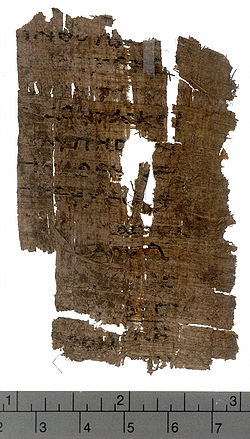- Papyrus 69
-
Manuskripte des Neuen Testaments
Papyri • Unziale • Minuskeln • LektionarePapyrus 69 Name P. Oxy 2383 Zeichen  69
69Text Lukas 22:41,45-48r+22:58-61v Sprache griechisch Datum 3. Jahrhundert Gefunden Oxyrhynchus, Ägypten Lagerort Papyrology Rooms, Sackler Library, Oxford Größe 8.5 × 5 cm Typ Westlicher Texttyp Kategorie IV Papyrus 69 (nach Gregory-Aland mit Sigel
 69 bezeichnet) ist eine frühe griechische Abschrift des Neuen Testaments. Es ist nur ein Fragment eines Papyrusmanuskripts des Lukasevangeliums. Mittels Paläographie wurde es auf das 3. Jahrhundert datiert.[1]
69 bezeichnet) ist eine frühe griechische Abschrift des Neuen Testaments. Es ist nur ein Fragment eines Papyrusmanuskripts des Lukasevangeliums. Mittels Paläographie wurde es auf das 3. Jahrhundert datiert.[1]Inhaltsverzeichnis
Beschreibung
In diesem Fragment fehlt der detaillierte Inhalt von Jesu Gebet in Lukas 22:42-45a vollständig.[2] In Lukas 22:61 schaut Petrus (nicht Jesus). Claire Clivaz schlug vor, dass
 69 (P. Oxy 2383) als „ein Zeugnis für eine Marcion-Ausgabe des Lukasevangeliums“ gewürdigt werden sollte.[3] Peter M Head hält die „Annahme, dass
69 (P. Oxy 2383) als „ein Zeugnis für eine Marcion-Ausgabe des Lukasevangeliums“ gewürdigt werden sollte.[3] Peter M Head hält die „Annahme, dass  69 eine Handschrift des Marcion-Evangeliums ist für eine sehr clevere Idee, die jedoch weder bewiesen noch die plausibelste Erklärung zum Kontext dieses faszinierenden Manuskriptes ist“.[4]
69 eine Handschrift des Marcion-Evangeliums ist für eine sehr clevere Idee, die jedoch weder bewiesen noch die plausibelste Erklärung zum Kontext dieses faszinierenden Manuskriptes ist“.[4]Der griechische Text des Kodex repräsentiert den Westlichen Texttyp. Gemäß Kurt Aland ist der Text sehr frei, „charakteristisch für Vorläufer des D-Textes“, daher ordnete er ihn in Kategorie IV ein.[5]
Text
[recto]
- [εις πειρασ]μ[ον] [41] κ̣[αι αυτος απεσ]
- [πασθη απ αυτων ωσ]ε̣ι λιθου β̣ο̣λ̣[ην]
- [και θεις τα γονατα προσ]η̣υ̣χ̣ε̣τ̣ο̣
- [45] [ελθων προς τους μ̣αθ]ητ[ας ευ]
- [ρεν αυτους καθευ]δοντας κοι
- [μωμενους αυτους απο τη]ς̣ λυπης [46] [κ]α̣ι̣
- [ειπεν αυτοις] τ̣ι κ̣α̣θευδ̣ε
- [τε ανασταντες πρ]ο̣σ̣ευχεσ̣θ̣ε
- [ινα μη εισελθητε εις πει]ρ̣ασμ̣ο̣ν̣
- [47] [ετι δε αυτου λαλουντος ι]δου̣
- [οχλος και ο λεγομενος ιου]δ̣ας
- [εις των ι̅β̅ προηρχετο α]υ̣[τ]ους
- [και εγγισας εφιλησε]ν̣ τ̣ον ι̣̅η̅ν̅
- [48] [ι̅η̅ς̅ δε ειπεν αυτω ιουδα φι]λ̣η̣[ματι
[verso]
- [58] – [ιδων] α̣υ̣[τ]ω̣ ε̣[φη και συ εξ αυτων ει]
- ο̣ δ̣ε ειπεν [α̅ν̅ε̅ ουκ ειμι [59] και δι]
- α̣σ̣τασης ωσ̣[ει ωρας α̅ αλλος τις ισχυ]
- ριζ̣ετο λεγω[ν επ αληθειας και]
- ου̣τ̣ο̣ς ην μ[ετ αυτου και γαρ γα]
- λ̣[ι]λ̣α̣ιος εστ̣[ιν] [60] [ειπεν δε ο πετρος]
- α̣ν̣̅ε ουκ οι[δα ο λεγεις και ετι]
- αυτου λαλου̣[ντος παραχρημα]
- ε̣φωνησεν̣ [αλεκτωρ] [61] [και στρα]
- φεις ο πε̣τ̣ρ̣[ος ενεβλεψεν αυ]
- τω τοτε [υπεμνησθη ο πετρος]
- τ̣ου ρημ[ατος του κ̅υ̅ ως ειπεν]
- αυ̣τω π[ριν αλεκτορα φωνησαι ση]
- μ̣[ερον απαρνηση με τρις] [62] [και]
Einzelnachweise
- ↑ New Testament Transcripts Prototype an der Uni Münster
- ↑ Comfort, The Text of the Earliest New Testament Greek Manuscripts, 2001, S. 472.
- ↑ C. Clivaz, The Angel and the Sweat Like 'Drops of Blood' (Lk 22:43–44): P69 and f13, in: Harvard Theological Review 98, 2005, S. 420.
- ↑ http://evangelicaltextualcriticism.blogspot.com/2006/07/not-marcionite-manuscript.html
- ↑ Kurt und Barbara Aland, Der Text des Neuen Testaments. Einführung in die wissenschaftlichen Ausgaben sowie in Theorie und Praxis der modernen Textkritik. Deutsche Bibelgesellschaft, Stuttgart 1989, S. 110. ISBN 3-438-06011-6
Literatur
- Claire Clivaz: The Angel and the Sweat Like “Drops of Blood” (Lk 22:43-44): P69 and f13. In: Harvard Theological Review. 98, 2005, doi:10.1017/S0017816005001045 (Preprint; PDF, 98 KB).
- Ehrman & Plunkett: The Angel and the Agony: The Textual Problem of Luke 22:43 44. In: Catholic Biblical Quarterly. 45, 1983, S. 401–416.
- Peter M. Head: Christology and Textual Transmission: Reverential Alterations in the Synoptic Gospels. In: Novum Testamentum. Vol. 35, Fasc. 2, April 1993, S. 123–126.
- Thomas A. Wayment: A new transcription of POxy 2383 (P69). In: Novum Testamentum. 50, 2008, S. 351–357.
- The Oxyrhynchus Papyri XXIV (1957) 1-4 (Pl.), London
- Kurt Aland: Repertorium der griechischen christlichen Papyri I. Biblische Papyri. Berlin/New York 1976, S. 300 (Patristische Texte und Studien 18).
- E. G. Turner: The Typology of the Early Codex. Philadelphia 1977, S. 21 und 149.
- Kurt Aland, Barbara Aland: Der Text des Neuen Testaments. Einführung in die wissenschaftlichen Ausgaben sowie in Theorie und Praxis der modernen Textkritik. 2. erg. u. erw. Auflage. Stuttgart 1989, S. 2, 67, 103, 105, 110, 248.
- Kurt Aland: Alter und Entstehung des D-Textes im Neuen Testament. Betrachtung zu P69 und 0171. In: S. Janeras (Hrsg.): Miscellànea papirològica Ramo Roca-Puig. Barcelona 1987, S. 37–61.
- J. K. Elliott: Codex Bezae and the Earliest Greek Papyri. In: D. C. Parker, C.-B. Amphoux (Hrsg.): Codex Bezae. Studies from the Lunel Colloquium, June 1994. Leiden 1996.
- Ph. W. Comfort, D. P. Barrett: The Text of the Earliest New Testament Greek Manuscripts. A Corr., Enlarged Ed. of The Complete Text of the Earliest New Testament Manuscripts. Wheaton/Ill. 2001, S. 470–472.
- J. K. Elliott: A Bibliography of Greek New Testament Manuscripts. 2. Auflage. Cambridge 2000, S. 34.
Wikimedia Foundation.

